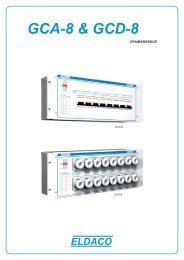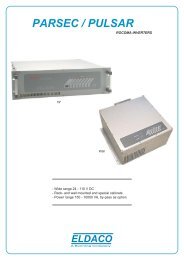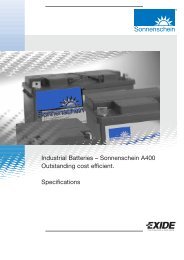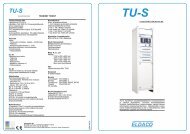Single and three phase inverters
Single and three phase inverters
Single and three phase inverters
Create successful ePaper yourself
Turn your PDF publications into a flip-book with our unique Google optimized e-Paper software.
4<br />
INVERTRONIC<br />
BENNING World Class Power Solutions<br />
multi utilities<br />
Internal manual bypass<br />
Each inverter is equipped with a maintenance bypass with<br />
manually operated switch. When operated, the Inverter is<br />
completely disconnected from the load. The supply to the<br />
load is now directly from the mains via the manual bypass.<br />
Instrumentation<br />
A background-lit 4 x 20 alphanumeric liquid Crystal display<br />
(LCD), which is operated by push buttons, is built into<br />
the front door. This unit indicates the following specified<br />
measured values:<br />
Inverter: · input voltage<br />
· input current<br />
· output voltage,<br />
· output current of each <strong>phase</strong> <strong>and</strong> frequency<br />
· apparent power<br />
· real power<br />
Bypass:<br />
· input voltage,<br />
· input current of each <strong>phase</strong> <strong>and</strong> frequency<br />
An event recorder stores each occurring event (push button<br />
operation, switching events <strong>and</strong> error) with date <strong>and</strong> time. Up<br />
to 1199 entries can be stored.<br />
Fig. 3: Interior view<br />
Front Panel<br />
The operation of the inverter is made by a plastic foil keyboard<br />
with 6 keys, 2 <strong>three</strong> coloured <strong>and</strong> 4 single coloured<br />
LED’s. There is a mimic diagram on the operating section.<br />
The operating condition <strong>and</strong> any operational disturbances are<br />
represented by the multi colour LED’s.<br />
There is a 4-line, 80-digit LC display in the operating section<br />
for reading information <strong>and</strong>/or for clear guidance by the<br />
menu. Control of the operating section takes place via the<br />
display controller, which communicates over the CAN bus<br />
with the controller board.<br />
In addition, the most important operating <strong>and</strong> fault signals<br />
are indicated by 13 single LED’s.<br />
Parallel Operation<br />
For redundancy or increased output power, up to eight<br />
INVERTRONIC units can be connected in parallel, operating in<br />
an active load-sharing mode.<br />
Half load parallel operation is achieved using two separate<br />
bus bars, connected with a coupling switch. The state of the<br />
coupling switch is relayed to the microprocessor, via an<br />
auxiliary contact.<br />
Option<br />
For power plant applications where higher than normal fault<br />
clearing current is required, it is possible to specify an option<br />
for 4 x I nominal system output. Depending on the output<br />
power, a bigger cabinet may be required.<br />
Fig. 4:<br />
Front Panel<br />
INVERTRONIC<br />
Auxiliary power supply<br />
Inverter operation<br />
Bypass operation<br />
Parallel operation<br />
Manuell bypass<br />
Overload<br />
Inverter failure<br />
Mains failure<br />
Battery voltage low<br />
140 %<br />
120 %<br />
100 %<br />
80 %<br />
60 %<br />
Fig. 5:<br />
Available inverter<br />
apparent<br />
output power<br />
depending on<br />
power factor<br />
40 %<br />
20 %<br />
LED Test<br />
0% 0 0,2 0,4 0,6 0,8 1 0,8 0,6 0,4 0,2 0<br />
leading<br />
power factor<br />
lagging



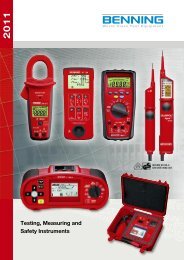

![2008-03-03 Ãbersichten [de-en-ru-fr].indd](https://img.yumpu.com/27509296/1/184x260/2008-03-03-abersichten-de-en-ru-frindd.jpg?quality=85)
